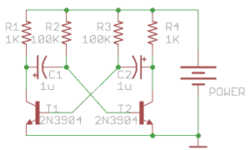Multivibrator – back to basics

Multivibrator circuit is one of the first projects you start learning electronics. It is a beautiful circuit widely used for educational purposes and even in end projects as waveform generators. Lots of hobbyists grab a microcontroller/Arduino to blink LEDs. But using basic circuits like multivibrator may be cheaper, faster, and even fun. [Ray] decided to go through multivibrator theory and explain its working in detail step by step. The circuit itself consists of two transistors, two capacitors, and four resistors. When powered, the circuit generates a square wave signal that can be used to flash LEDs or clock other circuits. You will get an intuition on what causes multivibrator to develop generate. Formulas allow calculating resistor and capacitor values for a particular frequency. If you are a starter in electronics, build one on a breadboard and do some experiments, why not start with Christmas lights.





